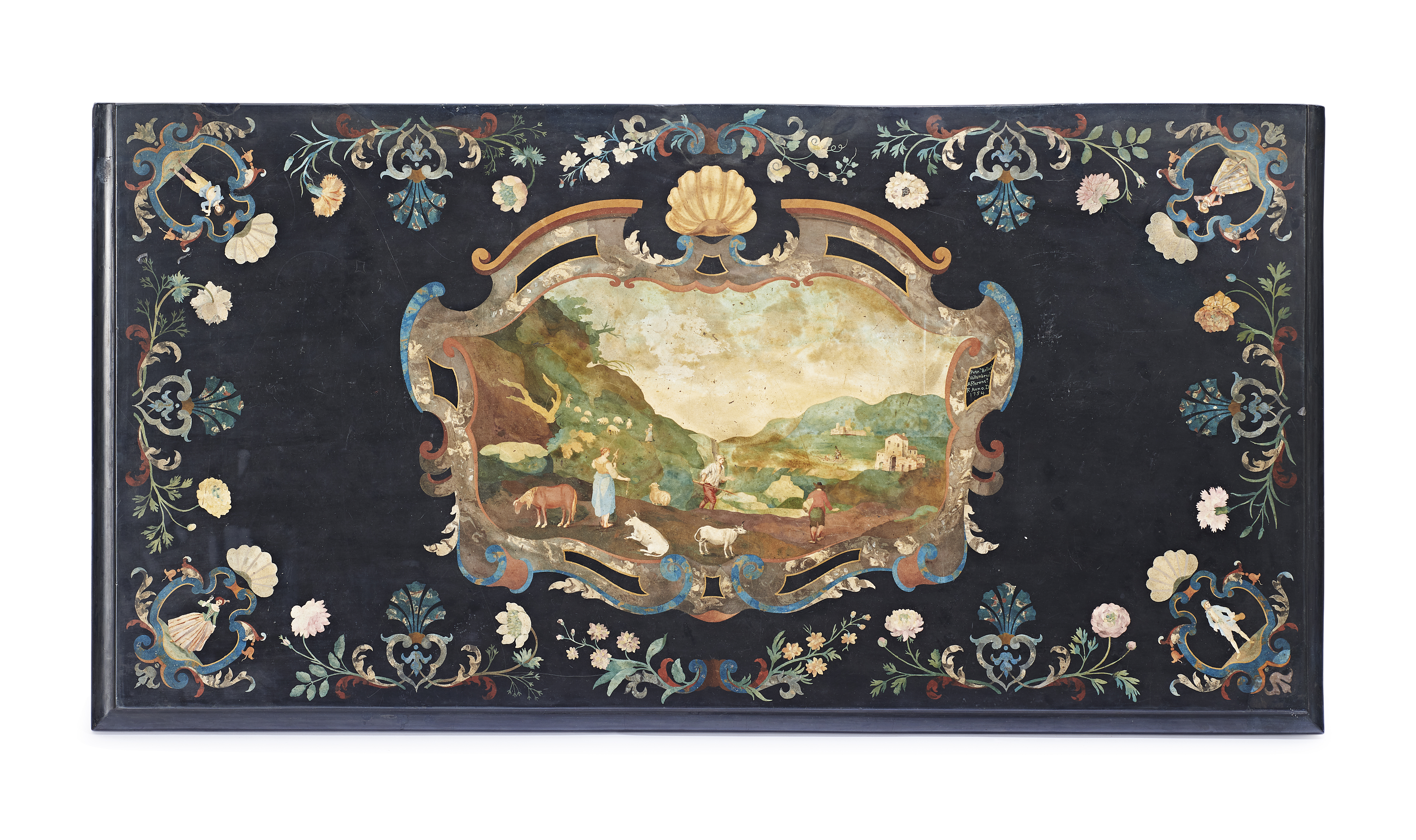Furniture, Works of Art and Clocks - 9th January 2019
Lot 376
A rare mid-18th century Italian Florentine Grand Tour scagliola table top by Don Pietro Belloni
Estimate £20,000 - £30,000 | Hammer £20000
+ Buyers Premium
Description

A rare mid-18th century Italian Florentine Grand Tour scagliola table top by Don Pietro Belloni, the black ground decorated with a central pastoral landscape panel depicting figures, cows, a horse and sheep, with a river beyond with buildings, within a pierced and scrolled cartouche with a shell surmount, with scrolled shell and floral borders, with Commedia dell'arte figures in cartouches to the corners, signed and dated 'Petro. Belloni. Vallumbrosa. A Florenta. F. Anno. D 1754', with a three quarter moulded edge, 71.5 x 139.5cm, 5cm deep.
Provenance: Purchased by the vendor's parents from Stair & Company Ltd. Successors to R. L. Harrington Ltd., 120 and 125 Mount Street, London, 19th May 1972.
Don Pietro Belloni was a monk at the monastery of Vallombrosa near Florence and assistant to the abbot, Don Enrico Hugford. Enrico Hugford (1695-1771) was born in Florence, the son of a watch maker who emigrated to Italy to work for Cosimo III. He took orders in 1711 at the monastery of Santa Reparata in Marradi. Marradi was the site where selenite (a mineral essential for the working of scagliola) was quarried and it is here where the young Hugford learnt the technique of scagliola. According to John Fleming it was
Hugford who 'advanced scagliola from being merely a cheap and easily worked substitute for marble and mosaic to a medium of such refinement that landscapes and figures could be depicted in it'. Don Enrico's work soon became much sought after by the English Grand Tourists of the day, especially large table tops to grace their country houses. In 1742 Sir Horace Mann paid Hugford 25 zecchins for a table top which he gave to Horace Walpole. Under Hugford's tutelage Belloni also began to produce scagliola slabs to satisfy the demand from the 'English milords' and his work is much better documented.
The present lot fits into a group of table tops supplied to a small coterie of Anglo-Irish Grand Tourists who were in Rome in the middle of the 18th century. This group of friends comprised Joseph Leeson of Russborough House, Wicklow, Matthew Fetherstonhaugh of Uppark, West Sussex, Ralph Howard of Shelton Abbey, Wicklow and Robert Clements of Killadoon. Their similar tastes are indicated by the fact whilst in Rome they all had their portraits painted by Pompeo Batoni and they had commissioned landscape paintings by Claude Joseph Vernet.
The table tops are all of a similar design, with a central landscape panel after painters such as Visentini and Locatelli, within a cartouche with floral and shell borders, some decorated with fruit, others with animals and Commedia dell'arte figures.
A pair was supplied to Joseph Leeson of Russborough, Co. Wicklow in 1750. They are mentioned in correspondence between Sir Horace Mann (the English minister in Florence) and Horace Walpole on the 11th June 1747. 'Here is a scholar of his (Hugford) but vastly inferior to him and so slow in working that he has been almost three years about a pair for a Mr Leson and requires six months more.' While Belloni may have been criticised by Mann as being 'inferior' to Enrico Hugford, and for his slowness, the table tops he produced for Leeson and his friends are examples of the scagliola technique at its finest. According to Jonathan Cook in his article 'Masters of the Art of Scagliola', these remarks with regards to Belloni were unjust and 'to judge from his surviving work his technical abilities and decorative style was of a parity with his master'.
Another pair, dated '1750', was supplied to Ralph Howard for his house, Shelton Abbey, and a pair dated '1754' were commissioned by Sir Matthew Fetherstonhaugh for his house, Uppark, in Sussex.
It is surprising that no tables are known for Robert Clements, later 1st Earl of Leitrim, and there is a distinct possibility that this present lot could well be a missing table top commissioned by Clements. The date is the same as the Uppark pair and the decoration is very similar to the Leeson tables, now in the Nati